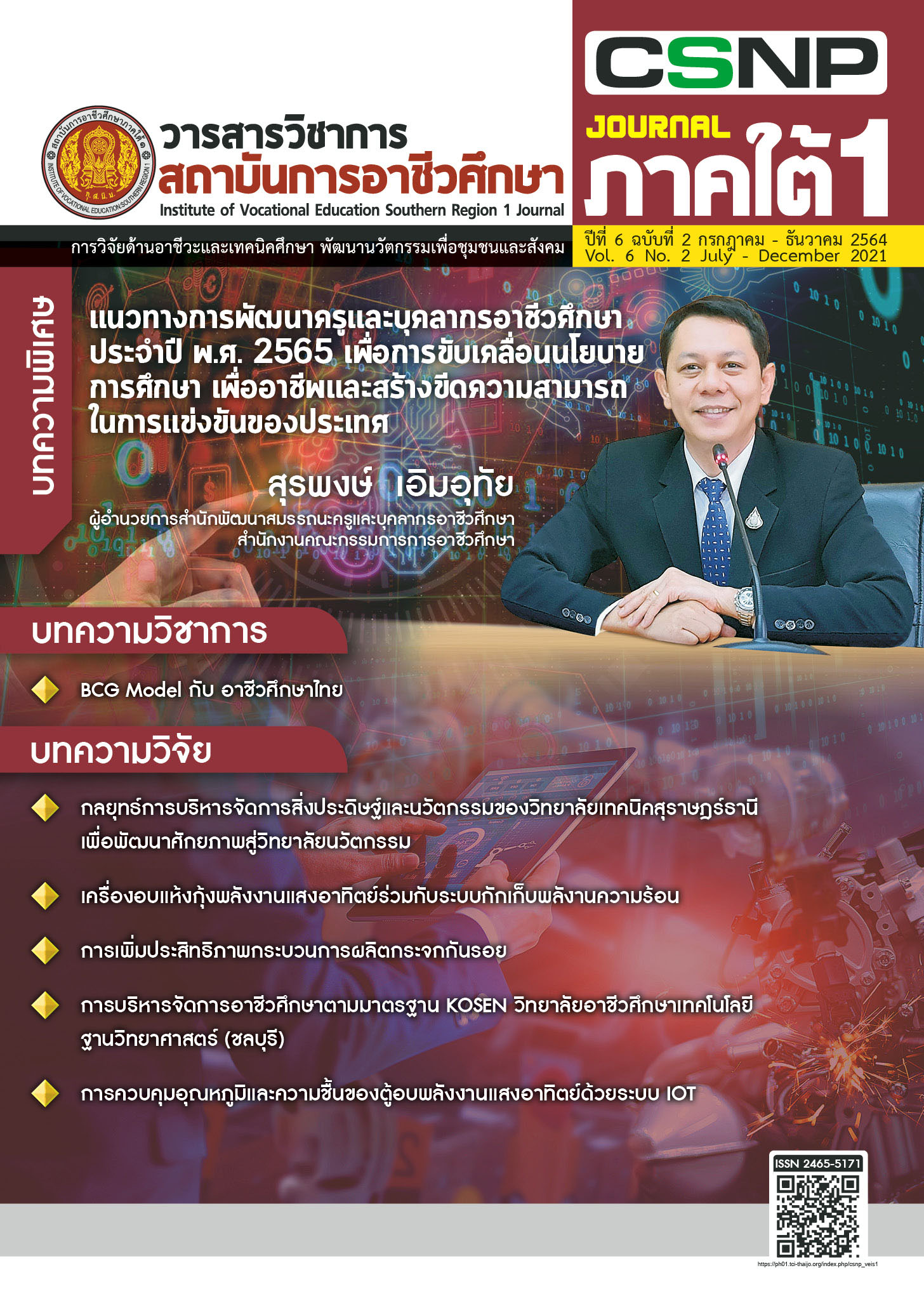BCG Model and Thai Vocational Education
Keywords:
Economic Model, Technology, Innovation, Vocational Education, Sustainable DevelopmentAbstract
This article aims to give the knowledge on the BCG Model, which is an economic model for sustainable development as well as presenting the concept of applying the BCG Model and applying it to the development of teaching and learning of vocational education for the development of the country by using the BCG Economy or Bio-Economics circular economy and green economy (Bio-Circular-Green Economy). The concept integrates the principles of science, technology, and innovation to enhance sustainable competitiveness of the 4 target industries (S-curves), namely agricultural and food industries, energy and materials industry, health and medical industry, and the tourism and service industries. Science technology and innovation will help increase the efficiency of producers who are the original production bases such as farmers and communities as well as to encourage entrepreneurs to produce goods and services with high added value or innovation.
This includes the vocational workforce development of both government and private sectors across the country to increase the knowledge base on technology, research, and innovation in line with the direction of vocational education workforce development to meet the BCG drive. The focus is on the integration of potential personnel in vocational education and local resources to meet the BCG policy of the country in 4 groups, i.e. 1) food processing and health products, 2) public health, health and medical technology, 3) innovation for tourism and creative economy, and 4) the development of artificial intelligence technology smart device energy and environment. However, the application of various concepts can be integrated into all activities, including teaching and learning, vocational education. innovation and invention and professional services.
References
สำนักงานพัฒนาวิทยาศาสตร์และเทคโนโลยีแห่งชาติ (สวทช.). (2563). [ออนไลน์]. BCG in Action: The New Sustainable Growth Engine โมเดลเศรษฐกิจสู่การพัฒนาที่ยั่งยืน. [สืบค้นเมื่อวันที่ 18 ตุลาคม 2564]. จาก https://www.nstda.or.th/home/knowledge_post/bcg-in-action-new-sustainable/.
สำนักงานพัฒนาวิทยาศาสตร์และเทคโนโลยีแห่งชาติ (สวทช.). (2562). [ออนไลน์]. (ร่าง) แผนปฏิบัติการด้านการขับเคลื่อนการพัฒนาประเทศไทยด้วยโมเดลเศรษฐกิจ BCG พ.ศ. 2564-2570. [สืบค้นเมื่อวันที่ 20 ตุลาคม 2564]. จาก https://www.bcg.in.th/bcg-action-plan/.
กระทรวงการอุดมศึกษา วิทยาศาสตร์ วิจัยและนวัตกรรม. (2562). ข้อเสนอ BCG in Action: The New Sustainable Growth Engine. กรุงเทพมหานคร.
สำนักงานคณะกรรมการการอาชีวศึกษา. (2561). [ออนไลน์]. วิสัยทัศน์/พัทธกิจ/ยุทธศาสตร์ (ปี พ.ศ.2561 - ปีพ.ศ.2564). [สืบค้นเมื่อวันที่ 19 ตุลาคม 2564]. จาก https://www.vec.go.th/th-th/เกี่ยวกับสอศ/วิสัยทัศน์พัทธกิจยุทธศาสตร์(ปีพศ2561-ปีพศ2564).aspx.
สำนักงานสภานโยบายการอุดมศึกษา วิทยาศาสตร์ วิจัยและนวัตกรรมแห่งชาติ (สอวช.). (2563). [ออนไลน์]. BCG in Action: The New Sustainable Growth Engine. [สืบค้นเมื่อวันที่ 13 ตุลาคม 2564]. จาก https://www.nxpo.or.th/th/bcg-economy/.
ประชาคมวิจัยด้านเศรษฐกิจชีวภาพ เศรษฐกิจหมุนเวียนและเศรษฐกิจสีเขียว. (2561). สมุดปกขาว BCG in Action การพัฒนาวิทยาศาสตร์ เทคโนโลยีและนวัตกรรมของประเทศไทย เพื่อเศรษฐกิจชีวภาพ เศรษฐกิจหมุนเวียนและเศรษฐกิจสีเขียว Bio - Circular - Green Economy. กรุงเทพมหานคร: ประชาคมวิจัยด้านเศรษฐกิจชีวภาพ เศรษฐกิจหมุนเวียนและเศรษฐกิจสีเขียว.
Downloads
Published
Issue
Section
License
Copyright (c) 2021 Institute of Vocational Education Southern Region 1 Journal

This work is licensed under a Creative Commons Attribution-NonCommercial-NoDerivatives 4.0 International License.



